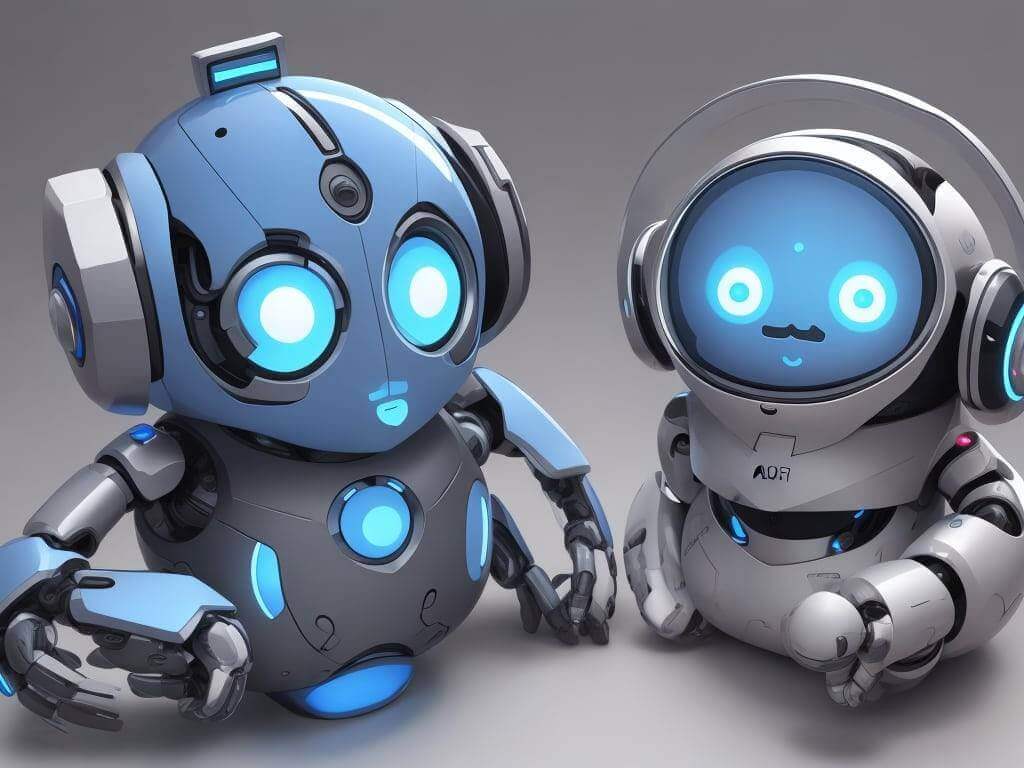The Rise of AI Chatbots in Customer Service
In today’s fast-paced and digital world, customers expect efficient and personalized service from businesses. With the increasing demand for instant support and round-the-clock availability, companies are turning to AI chatbots as a solution. AI chatbots have emerged as a powerful tool in customer service, revolutionizing the way businesses interact with their customers.
Understanding AI Chatbots: What Are They and How Do They Work?
AI chatbots are computer programs that use artificial intelligence and natural language processing to simulate human conversation. They are designed to understand and respond to customer queries in a conversational manner. AI chatbots can be deployed on various platforms, such as websites, messaging apps, and social media platforms.
These chatbots work by analyzing customer queries, extracting relevant information, and generating appropriate responses. They use machine learning algorithms to continuously improve their performance and understand customer intent better. AI chatbots can handle a wide range of tasks, from answering frequently asked questions to providing personalized recommendations.
There are different types of AI chatbots, including rule-based chatbots and self-learning chatbots. Rule-based chatbots follow a predefined set of rules and can only respond to specific queries. On the other hand, self-learning chatbots use machine learning algorithms to learn from customer interactions and improve their responses over time.
The Benefits of AI Chatbots for Customer Service
1. 24/7 availability: One of the significant advantages of AI chatbots is their ability to provide round-the-clock support. Unlike human representatives who have limited working hours, chatbots can handle customer queries at any time of the day. This ensures that customers can get assistance whenever they need it, leading to increased customer satisfaction.
2. Faster response times: AI chatbots can provide instant responses to customer queries, eliminating the need for customers to wait for a human representative. This significantly reduces response times and improves the overall customer experience. Customers no longer have to wait in long queues or be put on hold, resulting in higher customer satisfaction levels.
3. Cost-effective: Implementing AI chatbots can be a cost-effective solution for businesses. Chatbots can handle a large volume of customer inquiries simultaneously, reducing the need for a large customer service team. This leads to cost savings for businesses, as they can allocate resources more efficiently.
4. Scalability: AI chatbots can easily scale to handle a growing number of customer inquiries. As businesses expand and attract more customers, chatbots can handle the increased workload without compromising on response times or quality of service. This scalability ensures that businesses can meet customer demands effectively.
5. Consistency: AI chatbots provide consistent and accurate responses to customer queries. Unlike human representatives who may have different levels of knowledge or experience, chatbots follow predefined rules and guidelines. This ensures that customers receive consistent information and support, leading to a more reliable customer experience.
How AI Chatbots Can Improve Customer Satisfaction
1. Personalization: AI chatbots can collect and analyze customer data to provide personalized responses and recommendations. By understanding customer preferences and past interactions, chatbots can tailor their responses to individual needs. This personalization enhances the customer experience and increases customer satisfaction.
2. Quick and accurate responses: AI chatbots are designed to provide quick and accurate responses to customer queries. They can instantly retrieve information from databases or knowledge bases, eliminating the need for customers to wait for a human representative to find the information. This reduces customer frustration and improves satisfaction levels.
3. Reduced wait times: With AI chatbots, customers no longer have to wait in long queues or be put on hold. Chatbots can handle multiple inquiries simultaneously, ensuring that customers receive prompt assistance. This reduces wait times and improves the overall customer experience.
4. Multilingual support: AI chatbots can provide support in multiple languages, making them a valuable tool for businesses with a global customer base. Customers can interact with chatbots in their preferred language, eliminating language barriers and improving customer satisfaction.
The Role of AI Chatbots in Streamlining Customer Service Operations
1. Automating repetitive tasks: AI chatbots can automate repetitive tasks, such as answering frequently asked questions or providing basic information. This frees up human representatives to focus on more complex and high-value tasks, improving efficiency and productivity.
2. Routing inquiries to the right department: AI chatbots can analyze customer queries and route them to the appropriate department or team. This ensures that inquiries are handled by the most qualified representatives, reducing the need for customers to be transferred multiple times. This streamlines the customer service process and improves the overall customer experience.
3. Reducing workload for human representatives: By handling a significant portion of customer inquiries, AI chatbots can reduce the workload for human representatives. This allows them to focus on more complex and specialized tasks, leading to higher job satisfaction and improved performance.
4. Improving efficiency and productivity: AI chatbots can handle a large volume of customer inquiries simultaneously, improving the efficiency and productivity of customer service operations. With faster response times and reduced wait times, businesses can handle more inquiries in less time, resulting in higher customer satisfaction levels.
AI Chatbots and Personalization: Enhancing the Customer Experience
1. Collecting and analyzing customer data: AI chatbots can collect and analyze customer data, such as past interactions, preferences, and purchase history. This data can be used to understand customer needs and preferences better, enabling chatbots to provide more personalized responses.
2. Tailoring responses to individual needs: By leveraging customer data, AI chatbots can tailor their responses to individual needs. They can provide personalized recommendations, suggest relevant products or services, and offer targeted promotions. This level of personalization enhances the customer experience and increases customer satisfaction.
3. Providing personalized recommendations: AI chatbots can use customer data to provide personalized recommendations based on individual preferences and past interactions. This can help customers discover new products or services that are relevant to their needs, leading to increased customer satisfaction and loyalty.
4. Building customer loyalty: By providing personalized and tailored experiences, AI chatbots can build customer loyalty. When customers feel understood and valued, they are more likely to continue doing business with a company. This loyalty can lead to repeat purchases, positive word-of-mouth referrals, and long-term customer relationships.
The Future of Customer Service: AI Chatbots and Beyond
1. Advancements in AI technology: AI technology is continuously evolving, and advancements in natural language processing and machine learning are making chatbots more intelligent and capable. Future AI chatbots may be able to understand and respond to more complex queries, provide more accurate recommendations, and even engage in more natural and human-like conversations.
2. Integration with other technologies: AI chatbots can be integrated with other technologies, such as voice recognition and virtual reality, to provide even more immersive and interactive customer experiences. For example, chatbots could be used in virtual reality environments to assist customers with product demonstrations or troubleshooting.
3. The potential for virtual assistants: AI chatbots have the potential to evolve into virtual assistants that can handle a wide range of tasks beyond customer service. Virtual assistants could assist with scheduling appointments, making reservations, or even managing personal finances. This would further streamline and enhance the customer experience.
Implementing AI Chatbots: Best Practices and Considerations
1. Identifying use cases: Before implementing AI chatbots, businesses should identify specific use cases where chatbots can add value. This could be handling frequently asked questions, providing basic information, or assisting with order tracking. By focusing on specific use cases, businesses can ensure that chatbots are deployed effectively.
2. Choosing the right chatbot platform: There are various chatbot platforms available, each with its own features and capabilities. Businesses should carefully evaluate different platforms and choose the one that best fits their needs. Factors to consider include ease of integration, scalability, and the ability to customize the chatbot’s behavior.
3. Designing a conversational flow: The conversational flow of the chatbot is crucial for providing a seamless customer experience. Businesses should design a conversational flow that is intuitive and easy to navigate. This includes defining the chatbot’s responses, providing clear instructions to customers, and incorporating fallback options for when the chatbot cannot understand a query.
4. Testing and refining the chatbot: Before deploying the chatbot, businesses should thoroughly test its performance and refine its responses. This includes testing the chatbot’s ability to understand different queries, evaluating its accuracy and relevance of responses, and making necessary adjustments based on customer feedback.
Overcoming Challenges in AI Chatbot Implementation
1. Ensuring accuracy and relevance of responses: AI chatbots may sometimes provide inaccurate or irrelevant responses, which can frustrate customers. To overcome this challenge, businesses should continuously monitor and evaluate the chatbot’s performance, and make necessary adjustments to improve its accuracy and relevance.
2. Addressing privacy and security concerns: AI chatbots handle sensitive customer information, such as personal details or order history. Businesses must ensure that appropriate security measures are in place to protect customer data and address privacy concerns. This includes implementing encryption protocols, complying with data protection regulations, and providing clear privacy policies to customers.
3. Managing customer expectations: Customers may have high expectations when interacting with AI chatbots, expecting them to provide human-like responses or solve complex problems. Businesses should manage customer expectations by clearly communicating the capabilities and limitations of the chatbot. This can help avoid customer frustration and disappointment.
4. Providing human backup when needed: While AI chatbots can handle a wide range of customer inquiries, there may be situations where human intervention is necessary. Businesses should have a system in place to seamlessly transfer customers to human representatives when needed. This ensures that customers receive the support they need and maintains a positive customer experience.
AI Chatbots and Data Analytics: Leveraging Insights for Better Customer Service
1. Collecting and analyzing customer data: AI chatbots can collect valuable customer data, such as customer preferences, behavior patterns, and feedback. This data can be analyzed to gain insights into customer needs and preferences, enabling businesses to improve their products, services, and overall customer experience.
2. Identifying trends and patterns: By analyzing customer data, businesses can identify trends and patterns that can help them make informed decisions. For example, businesses can identify common customer pain points or areas for improvement in their products or services. This data-driven approach can lead to more targeted and effective customer service strategies.
3. Improving the chatbot’s performance: Data analytics can be used to continuously improve the performance of AI chatbots. By analyzing customer interactions and feedback, businesses can identify areas where the chatbot may be struggling or providing inaccurate responses. This data can then be used to refine the chatbot’s behavior and enhance its performance.
4. Making data-driven decisions: The insights gained from data analytics can help businesses make data-driven decisions regarding their customer service strategies. For example, businesses can identify areas where additional training or resources may be needed for human representatives. This data-driven approach ensures that businesses are continuously improving their customer service operations based on real-time data.
The Human Touch: Balancing AI Chatbots and Human Customer Service Representatives
1. The importance of human interaction: While AI chatbots offer many benefits, human interaction is still crucial in customer service. There are situations where customers may require empathy, emotional support, or complex problem-solving that only a human representative can provide. Businesses should strike a balance between AI chatbots and human representatives to ensure a seamless customer experience.
2. When to involve human representatives: Businesses should define clear guidelines for when to involve human representatives in customer interactions. This could be based on the complexity of the query, the emotional state of the customer, or the need for specialized knowledge. By involving human representatives at the right time, businesses can provide a personalized and empathetic customer experience.
3. Training human representatives to work with chatbots: Human representatives should be trained to work effectively with AI chatbots. This includes understanding the capabilities and limitations of chatbots, knowing when to escalate a query to a human representative, and maintaining a seamless transition between the chatbot and human interaction. This training ensures that human representatives can provide the necessary support and maintain a positive customer experience.
4. Maintaining a seamless customer experience: Businesses should ensure that the transition between AI chatbots and human representatives is seamless for customers. This includes transferring relevant information from the chatbot to the human representative, providing context for the query, and avoiding repetition of information. By maintaining a seamless customer experience, businesses can provide the best of both worlds – the efficiency of AI chatbots and the personal touch of human representatives.
Conclusion: The Power of AI Chatbots in Revolutionizing Customer Service

Revolutionizing Customer Service: The Power of AI Chat Open Assistant Chatbots
Introduction: The Rise of AI Chatbots in Customer Service
In today’s fast-paced and digital world, customers expect efficient and personalized service from businesses. With the increasing demand for instant support and round-the-clock availability, companies are turning to AI chatbots as a solution. AI chatbots have emerged as a powerful tool in customer service, revolutionizing the way businesses interact with their customers.
Understanding AI Chatbots: What Are They and How Do They Work?
AI chatbots are computer programs that use artificial intelligence and natural language processing to simulate human conversation. They are designed to understand and respond to customer queries in a conversational manner. AI chatbots can be deployed on various platforms, such as websites, messaging apps, and social media platforms.
These chatbots work by analyzing customer queries, extracting relevant information, and generating appropriate responses. They use machine learning algorithms to continuously improve their performance and understand customer intent better. AI chatbots can handle a wide range of tasks, from answering frequently asked questions to providing personalized recommendations.
There are different types of AI chatbots, including rule-based chatbots and self-learning chatbots. Rule-based chatbots follow a predefined set of rules and can only respond to specific queries. On the other hand, self-learning chatbots use machine learning algorithms to learn from customer interactions and improve their responses over time.
The Benefits of AI Chatbots for Customer Service
1. 24/7 availability: One of the significant advantages of AI chatbots is their ability to provide round-the-clock support. Unlike human representatives who have limited working hours, chatbots can handle customer queries at any time of the day. This ensures that customers can get assistance whenever they need it, leading to increased customer satisfaction.
2. Faster response times: AI chatbots can provide instant responses to customer queries, eliminating the need for customers to wait for a human representative. This significantly reduces response times and improves the overall customer experience. Customers no longer have to wait in long queues or be put on hold, resulting in higher customer satisfaction levels.
3. Cost-effective: Implementing AI chatbots can be a cost-effective solution for businesses. Chatbots can handle a large volume of customer inquiries simultaneously, reducing the need for a large customer service team. This leads to cost savings for businesses, as they can allocate resources more efficiently.
4. Scalability: AI chatbots can easily scale to handle a growing number of customer inquiries. As businesses expand and attract more customers, chatbots can handle the increased workload without compromising on response times or quality of service. This scalability ensures that businesses can meet customer demands effectively.
5. Consistency: AI chatbots provide consistent and accurate responses to customer queries. Unlike human representatives who may have different levels of knowledge or experience, chatbots follow predefined rules and guidelines. This ensures that customers receive consistent information and support, leading to a more reliable customer experience.
How AI Chatbots Can Improve Customer Satisfaction
1. Personalization: AI chatbots can collect and analyze customer data to provide personalized responses and recommendations. By understanding customer preferences and past interactions, chatbots can tailor their responses to individual needs. This personalization enhances the customer experience and increases customer satisfaction.
2. Quick and accurate responses: AI chatbots are designed to provide quick and accurate responses to customer queries. They can instantly retrieve information from databases or knowledge bases, eliminating the need for customers to wait for a human representative to find the information. This reduces customer frustration and improves satisfaction levels.
3. Reduced wait times: With AI chatbots, customers no longer have to wait in long queues or be put on hold. Chatbots can handle multiple inquiries simultaneously, ensuring that customers receive prompt assistance. This reduces wait times and improves the overall customer experience.
4. Multilingual support: AI chatbots can provide support in multiple languages, making them a valuable tool for businesses with a global customer base. Customers can interact with chatbots in their preferred language, eliminating language barriers and improving customer satisfaction.
The Role of AI Chatbots in Streamlining Customer Service Operations
1. Automating repetitive tasks: AI chatbots can automate repetitive tasks, such as answering frequently asked questions or providing basic information. This frees up human representatives to focus on more complex and high-value tasks, improving efficiency and productivity.
2. Routing inquiries to the right department: AI chatbots can analyze customer queries and route them to the appropriate department or team. This ensures that inquiries are handled by the most qualified representatives, reducing the need for customers to be transferred multiple times. This streamlines the customer service process and improves the overall customer experience.
3. Reducing workload for human representatives: By handling a significant portion of customer inquiries, AI chatbots can reduce the workload for human representatives. This allows them to focus on more complex and specialized tasks, leading to higher job satisfaction and improved performance.
4. Improving efficiency and productivity: AI chatbots can handle a large volume of customer inquiries simultaneously, improving the efficiency and productivity of customer service operations. With faster response times and reduced wait times, businesses can handle more inquiries in less time, resulting in higher customer satisfaction levels.
AI Chatbots and Personalization: Enhancing the Customer Experience
1. Collecting and analyzing customer data: AI chatbots can collect and analyze customer data, such as past interactions, preferences, and purchase history. This data can be used to understand customer needs and preferences better, enabling chatbots to provide more personalized responses.
2. Tailoring responses to individual needs: By leveraging customer data, AI chatbots can tailor their responses to individual needs. They can provide personalized recommendations, suggest relevant products or services, and offer targeted promotions. This level of personalization enhances the customer experience and increases customer satisfaction.
3. Providing personalized recommendations: AI chatbots can use customer data to provide personalized recommendations based on individual preferences and past interactions. This can help customers discover new products or services that are relevant to their needs, leading to increased customer satisfaction and loyalty.
4. Building customer loyalty: By providing personalized and tailored experiences, AI chatbots can build customer loyalty. When customers feel understood and valued, they are more likely to continue doing business with a company. This loyalty can lead to repeat purchases, positive word-of-mouth referrals, and long-term customer relationships.
The Future of Customer Service: AI Chatbots and Beyond
1. Advancements in AI technology: AI technology is continuously evolving, and advancements in natural language processing and machine learning are making chatbots more intelligent and capable. Future AI chatbots may be able to understand and respond to more complex queries, provide more accurate recommendations, and even engage in more natural and human-like conversations.
2. Integration with other technologies: AI chatbots can be integrated with other technologies, such as voice recognition and virtual reality, to provide even more immersive and interactive customer experiences. For example, chatbots could be used in virtual reality environments to assist customers with product demonstrations or troubleshooting.
3. The potential for virtual assistants: AI chatbots have the potential to evolve into virtual assistants that can handle a wide range of tasks beyond customer service. Virtual assistants could assist with scheduling appointments, making reservations, or even managing personal finances. This would further streamline and enhance the customer experience.
Implementing AI Chatbots: Best Practices and Considerations
1. Identifying use cases: Before implementing AI chatbots, businesses should identify specific use cases where chatbots can add value. This could be handling frequently asked questions, providing basic information, or assisting with order tracking. By focusing on specific use cases, businesses can ensure that chatbots are deployed effectively.
2. Choosing the right chatbot platform: There are various chatbot platforms available, each with its own features and capabilities. Businesses should carefully evaluate different platforms and choose the one that best fits their needs. Factors to consider include ease of integration, scalability, and the ability to customize the chatbot’s behavior.
3. Designing a conversational flow: The conversational flow of the chatbot is crucial for providing a seamless customer experience. Businesses should design a conversational flow that is intuitive and easy to navigate. This includes defining the chatbot’s responses, providing clear instructions to customers, and incorporating fallback options for when the chatbot cannot understand a query.
4. Testing and refining the chatbot: Before deploying the chatbot, businesses should thoroughly test its performance and refine its responses. This includes testing the chatbot’s ability to understand different queries, evaluating its accuracy and relevance of responses, and making necessary adjustments based on customer feedback.
Overcoming Challenges in AI Chatbot Implementation
1. Ensuring accuracy and relevance of responses: AI chatbots may sometimes provide inaccurate or irrelevant responses, which can frustrate customers. To overcome this challenge, businesses should continuously monitor and evaluate the chatbot’s performance, and make necessary adjustments to improve its accuracy and relevance.
2. Addressing privacy and security concerns: AI chatbots handle sensitive customer information, such as personal details or order history. Businesses must ensure that appropriate security measures are in place to protect customer data and address privacy concerns. This includes implementing encryption protocols, complying with data protection regulations, and providing clear privacy policies to customers.
3. Managing customer expectations: Customers may have high expectations when interacting with AI chatbots, expecting them to provide human-like responses or solve complex problems. Businesses should manage customer expectations by clearly communicating the capabilities and limitations of the chatbot. This can help avoid customer frustration and disappointment.
4. Providing human backup when needed: While AI chatbots can handle a wide range of customer inquiries, there may be situations where human intervention is necessary. Businesses should have a system in place to seamlessly transfer customers to human representatives when needed. This ensures that customers receive the support they need and maintains a positive customer experience.
AI Chatbots and Data Analytics: Leveraging Insights for Better Customer Service
1. Collecting and analyzing customer data: AI chatbots can collect valuable customer data, such as customer preferences, behavior patterns, and feedback. This data can be analyzed to gain insights into customer needs and preferences, enabling businesses to improve their products, services, and overall customer experience.
2. Identifying trends and patterns: By analyzing customer data, businesses can identify trends and patterns that can help them make informed decisions. For example, businesses can identify common customer pain points or areas for improvement in their products or services. This data-driven approach can lead to more targeted and effective customer service strategies.
3. Improving the chatbot’s performance: Data analytics can be used to continuously improve the performance of AI chatbots. By analyzing customer interactions and feedback, businesses can identify areas where the chatbot may be struggling or providing inaccurate responses. This data can then be used to refine the chatbot’s behavior and enhance its performance.
4. Making data-driven decisions: The insights gained from data analytics can help businesses make data-driven decisions regarding their customer service strategies. For example, businesses can identify areas where additional training or resources may be needed for human representatives. This data-driven approach ensures that businesses are continuously improving their customer service operations based on real-time data.
The Human Touch: Balancing AI Chatbots and Human Customer Service Representatives
1. The importance of human interaction: While AI chatbots offer many benefits, human interaction is still crucial in customer service. There are situations where customers may require empathy, emotional support, or complex problem-solving that only a human representative can provide. Businesses should strike a balance between AI chatbots and human representatives to ensure a seamless customer experience.
2. When to involve human representatives: Businesses should define clear guidelines for when to involve human representatives in customer interactions. This could be based on the complexity of the query, the emotional state of the customer, or the need for specialized knowledge. By involving human representatives at the right time, businesses can provide a personalized and empathetic customer experience.
3. Training human representatives to work with chatbots: Human representatives should be trained to work effectively with AI chatbots. This includes understanding the capabilities and limitations of chatbots, knowing when to escalate a query to a human representative, and maintaining a seamless transition between the chatbot and human interaction. This training ensures that human representatives can provide the necessary support and maintain a positive customer experience.
4. Maintaining a seamless customer experience: Businesses should ensure that the transition between AI chatbots and human representatives is seamless for customers. This includes transferring relevant information from the chatbot to the human representative, providing context for the query, and avoiding repetition of information. By maintaining a seamless customer experience, businesses can provide the best of both worlds – the efficiency of AI chatbots and the personal touch of human representatives.
Conclusion: The Power of AI Chatbots in Revolutionizing Customer Service
In conclusion, AI chatbots have emerged as a powerful tool in customer service, revolutionizing the way businesses interact with their customers. With their ability to provide 24/7 availability, faster response times, cost-effectiveness, scalability, and consistency, AI chatbots offer numerous benefits for businesses. They can improve customer satisfaction through personalization, quick and accurate responses, reduced wait times, and multilingual support.
AI chatbots also play a crucial role in streamlining customer service operations by automating repetitive tasks, routing inquiries to the right department, reducing workload for human representatives, and improving efficiency and productivity. They enhance the customer experience through personalization, providing tailored responses and recommendations, and building customer loyalty.
The future of customer service holds even more potential for AI chatbots, with advancements in AI technology, integration with other technologies, and the potential for virtual assistants. However, businesses must implement AI chatbots carefully, considering best practices and overcoming challenges such as ensuring accuracy and relevance of responses, addressing privacy and security concerns, managing customer expectations, and providing human backup when needed.
By leveraging data analytics, businesses can gain valuable insights to improve their customer service strategies and make data-driven decisions. However, it is essential to strike a balance between AI chatbots and human representatives, recognizing the importance of human interaction and training human representatives to work effectively with chatbots.
Overall, AI chatbots have the power to transform the customer service industry by providing efficient and personalized support to customers. By harnessing the benefits and potential of AI chatbots while maintaining a human touch, businesses can revolutionize their customer service operations and deliver exceptional customer experiences.
In conclusion, AI chatbots have emerged as a powerful tool in customer service, revolutionizing the way businesses interact with their customers. With their ability to provide 24/7 availability, faster response times, cost-effectiveness, scalability, and consistency, AI chatbots offer numerous benefits for businesses. They can improve customer satisfaction through personalization, quick and accurate responses, reduced wait times, and multilingual support.
AI chatbots also play a crucial role in streamlining customer service operations by automating repetitive tasks, routing inquiries to the right department, reducing workload for human representatives, and improving efficiency and productivity. They enhance the customer experience through personalization, providing tailored responses and recommendations, and building customer loyalty.
The future of customer service holds even more potential for AI chatbots, with advancements in AI technology, integration with other technologies, and the potential for virtual assistants. However, businesses must implement AI chatbots carefully, considering best practices and overcoming challenges such as ensuring accuracy and relevance of responses, addressing privacy and security concerns, managing customer expectations, and providing human backup when needed.
By leveraging data analytics, businesses can gain valuable insights to improve their customer service strategies and make data-driven decisions. However, it is essential to strike a balance between AI chatbots and human representatives, recognizing the importance of human interaction and training human representatives to work effectively with chatbots.
Overall, AI chatbots have the power to transform the customer service industry by providing efficient and personalized support to customers. By harnessing the benefits and potential of AI chatbots while maintaining a human touch, businesses can revolutionize their customer service operations and deliver exceptional customer experiences.





